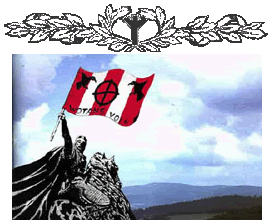The 'Wotansvolk flag as an Umbrella Symbol of European Neo-Paganism?' entry from last February has been one of the most viewed pieces ever published on this blog. I thought that it needed some slight clarification.
I am not specifically an Odinist. However, it seems obvious to me that it could be beneficial for there to exist a united-concept; a "European-American folkish neopagan concern." Not an organization, but more of a periodic panel.
The Odinic Rite makes some attempt at this by stating that they represent all pre-Christian faiths of North-Central/West Europe. Lets face it, there are concerns even within that idea which do not wish to be a wing of Odinism; and see themselves as a folk-family within themselves.
Recently, the California-based Asatru Folk Assembly--in an article regarding "folkishness"--at least hinted that Wicca was not of their people (Northern European). Well, lets examine that. On the surface, this would seem to be correct. Wicca attracts many people who, if I merely attempted to name them, would make me sound like a "hater"; but whom are infinitely different than we are, on many levels. On the other hand, Wicca is based on a magical tradition, chiefly from the British Isles as far as its specifics, and actually tied to magical traditions from all over Europe. Many of these spiritual traditions overlapped one-another, and the history of that is too much to go into now; but suffice to say that they often existed openly within (and even part of) more prevalent belief systems like Odinism. In other words, they ARE in essence from and of our people. It's an open secret that Odinism and the "magical traditions" (i.e. "witchcraft") have a lot of common themes.
I believe that Cernunnos, the chief god of the Gauls, developed from a long natural-syncretization between the native "horned god" (of many names) and Odin. Also, Odin--and other major gods like Cernunnos, Lugus, etc.--was associated to the Roman and Greek god Mercury. While this stemmed from an attempt to force-syncretize a new paradigm of Roman rule; there seems to have been some genuine tie-in (Odin-Mercury), written about by Guido von List in his book 'The Religion of the Aryo-Germanic Folk', which was unrelated to this policy. In addition, Slavic heathenism clearly has many ties and common themes to Odinism.
What I am driving at is that there is a strong basis, in an effort for a "European-American folkish neopagan concern", to utilize the Wotansvolk flag as a unifying symbol. The solar cross and the raven symbolism are tied deeply to a host of other European heathen traditions. Odinism, and all of it's folkish denominations, seems to overwhemingly be the major spiritual tradition that we're talking about here; past and present. It found its way, in some form, to every corner of Europe. Why not acknowledge that, and finally make good on this flag? The founder(s) of the flag must be given the full right to profit from it; regardless if it's patented or not.
One of the great failures of all of the folkish neopagan concerns applicable here, is the failure to connect solitary adherents of even their own spiritual path.... must less the unifying principle we're looking at here. Think of how often "solitaries" have lived in close proximity, but never connected. The reality of the situation is as follows: There are perhaps a dozen or so folkish neopagan concerns, each with many denominations. Collectively we represent a tiny minority of the population at large. There are a sizable number of "universalist neopagans" (mostly Wiccans), but they're not folkish; or even decent or honorable people in many cases. They probably outnumber us ten or twenty to one! Okay, that adds some additional confusion. So we find ourselves in this social rut that we should climb ourselves out of. We can solve this problem.
No individual or group needs to intrinsically change, just form a larger folkish outer social perimeter. Reach out locally. We don't need an organization, but new local structures and networks. It's more logical for this to start locally, and work it's way up; rather than the other way around. You can, as an individual, make a big impact locally. Your existing hearth or coven can remain entirely unchanged, and exist as a separate entity from a "loose local folkish neopagan milieu."
.


No comments:
Post a Comment